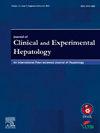脾脏面积影响基于血小板计数的无创工具在预测代谢功能障碍相关脂肪变性肝病肝硬化患者第一肝代偿中的作用
IF 3.2
Q2 GASTROENTEROLOGY & HEPATOLOGY
Journal of Clinical and Experimental Hepatology
Pub Date : 2025-05-27
DOI:10.1016/j.jceh.2025.102596
引用次数: 0
摘要
背景/目的预测晚期慢性肝病(ACLD)患者首次肝失代偿(HD)的各种非侵入性工具(NITs)都包含血小板(PLT)计数。相关比例的代谢功能障碍相关脂肪变性肝病(MASLD)- acld患者不表现脾肿大和脾功能亢进相关的血小板减少症。我们的目的是根据超声评估脾脏大小来评估NITs在预测HD方面的表现。方法本观察性研究纳入148例脾(ASP)和27例无脾(ASP) masld代偿的晚期慢性肝病(cACLD)患者。基于超声人工智能的工具区分脾肿大患者(SAPs)和脾正常患者(NSPs)。测定白蛋白-胆红素评分(ALBI)和基于PLT计数的NITs (pln) (Fbrosis-4 [FIB-4]、ALBI-FIB-4、红细胞分布宽度-PLT比[RPR]、肝硬度测量值[LSM]-血小板比[LSM/PLTr]和预期±非酒精性脂肪性肝炎[NASH])。3年后,第一部高清电影被录制下来。结果脾脏面积与PLT呈负相关(关系R:−0.981;P & lt;0.0001),证实脾大相关脾功能亢进在血小板减少症中的作用。HD在sap(20.48%)、NSPs(21.15%)和ASP(25%)患者中的发生率相似(P: 0.198)。在NSP中,与SAP相比,PLNs对HD (FIB-4 [P: 0.03], ALBI-FIB-4 [P: 0.001], RPR [P: 0.002], LSM/PLTr [P: 0.01],和预估±NASH [P: 0.001])的影响降低。在NSP中,脾脏面积呈负相关(调整后的亚分布风险比:0.870),且更为显著(P <;0.0001)影响HD。与sap不同的是,在NSP和ASP患者中,PLNs表现不佳,而ALBI保持了良好的准确性(NSP:曲线下面积[AUC]: 0.651, P: 0.04;ASP患者预测3年HD的AUC: 0.625, P: 0.03)。结论超声评估脾脏大小影响MASLD-cACLD患者pln的预测性能。本文章由计算机程序翻译,如有差异,请以英文原文为准。

Spleen Area Affects the Performance of the Platelet Count–Based Non-invasive Tools in Predicting First Hepatic Decompensation in Metabolic Dysfunction–Associated Steatotic Liver Disease Cirrhosis
Background/Aims
Various non-invasive tools (NITs) predicting first hepatic decompensation (HD) in advanced chronic liver disease (ACLD) enclose platelet (PLT) count. A relevant proportion of metabolic dysfunction–associated steatotic liver disease (MASLD)-ACLD patients do not show splenomegaly- and hypersplenism-related thrombocytopenia. We aimed to evaluate the performance of NITs in predicting HD according to ultrasound-assessed spleen size.
Methods
In this observational study, 148 splenic and 27 asplenic (ASP) MASLD-compensated advanced chronic liver disease (cACLD) patients were enrolled. Ultrasound artificial intelligence–based tools distinguished splenomegaly-affected patients (SAPs) and normal-spleen patients (NSPs). Albumin-Bilirubin score (ALBI) and PLT count–based NITs (PLNs) (Fbrosis-4 [FIB-4], ALBI-FIB-4, red cell distribution width-to-PLT ratio [RPR], liver stiffness measurement [LSM]-to-platelet ratio [LSM/PLTr], and ANTICIPATE ± non-alcoholic steatohepatitis [NASH]) were determined. Over 3 years, the first HD was recorded.
Results
Limitedly to SAP, spleen area inversely correlated with PLT (relationship [R]: −0.981; P < 0.0001), confirming the role of splenomegaly-related hypersplenism in conditioning thrombocytopenia. HD occurred similarly in SAPs (20.48%), NSPs (21.15%), and ASP patients (25%) (P: 0.198). In NSP, PLNs showed a reduced influence on HD (FIB-4 [P: 0.03], ALBI-FIB-4 [P: 0.001], RPR [P: 0.002], LSM/PLTr [P: 0.01], and ANTICIPATE ± NASH [P: 0.001]) compared to SAP. In NSP, the spleen area was inversely associated (adjusted sub-distribution hazard ratio: 0.870) and more significantly (P < 0.0001) impacted HD. Consistently, unlike SAPs, in NSPs and ASP patients, PLNs showed poor performance, and exclusively ALBI maintained a good accuracy (NSP: area under the curve [AUC]: 0.651, P: 0.04; ASP patients: AUC: 0.625, P: 0.03) in predicting 3-year HD.
Conclusion
Ultrasound-assessed spleen size affects the predictive performance of the PLNs in MASLD-cACLD patients.
求助全文
通过发布文献求助,成功后即可免费获取论文全文。
去求助
来源期刊

Journal of Clinical and Experimental Hepatology
GASTROENTEROLOGY & HEPATOLOGY-
CiteScore
4.90
自引率
16.70%
发文量
537
审稿时长
64 days
 求助内容:
求助内容: 应助结果提醒方式:
应助结果提醒方式:


